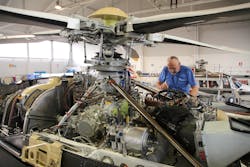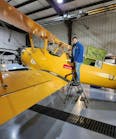AMT asked three turbine helicopter engine manufacturers to describe one of their most notable engines. Read about these engines, the airframes they power, and a few of the operating and maintenance aspects of each engine.
Pratt & Whitney Canada’s PW210 Engine
The PW210 is a 1,000 shaft horsepower class engine found on the Leonardo Helicopters AW169 and the Sikorsky S-76D. First delivered in July 2013, as of Oct. 31, 2018, the PW210 has accumulated some 175,000 flying hours on 260 active engines with 63 active operators.
P&WC touts improvements in fuel burn, power-to-weight ratio, and environmental emissions which mean minimum maintenance and low operating costs. The engine also offers HIP/SARM (hovering at increased power for search and rescue mission) allowing 30 minutes at takeoff power capability as well as a rotor brake and auxiliary power unit (APU) mode capability for passenger loading safety.
Some of the technical details of the PW210 include variable inlet guide vanes (VIGVs) and the full authority digital engine control (FADEC). The VIGVs improve engine operability and in turn maximize the aircraft’s handling performance. The FADEC system incorporates the EEC (electronic engine control), FCU (fuel control unit), DCU (data collection unit), multiple sensors (main oil pressure, fuel pressure, etc.) and more – all working together to provide automated and electronic features resulting in reduced pilot workload. The dual-channel FADEC ensures safety via redundancy, two channel control per engine, with all control functions available on both channels. The EEC continuously monitors the health of its inputs, internal hardware functions, and external driver circuits. When an input fault is detected, accommodation is provided by selecting an alternative healthy input.
The PW210 features an automatic starting, light-up, turbine temperature limiting, and hung start detection with start abort function if a problem is detected. Limiting is available in all engine operating regimes and will prevent the engine from exceeding either a speed, torque, or temperature limit. Power sharing is typically done by governing the torques of the two engines to the same value.
Pilot one engine inoperative (OEI) “training mode” is where both engines are operating at reduced power levels such that the sum of the power outputs from the two engines is equal to the total power available from one engine at the OEI ratings. This means that, should the pilot need to get out of training mode, both engines can react quickly to produce the required power.
Electronics give the flexibility of detecting and logging faults and exceedances.
Precise creep and low cycle fatigue (LCF) damage counting of critical components is possible and done automatically because the software continuously monitors engine speed and temperature.
In-flight automated engine power assurance check (EPAC) is being developed with the OEM and will be initiated based on pilot request. Results will be stored in the data collection unit (DCU). Trend monitoring can be done from the power assurance data if the power assurance is conducted following P&WC’s approach. The hot section inspection (HSI) is on-condition and is based on the EPAC results.
Maintenance features on the PW210 include a line maintenance kit containing tooling to perform “on-wing” maintenance for seal replacement, oil servicing, and compressor turbine wash. Diagnostics of FADEC system are available via ground based software (GBS) “maintenance collection” that is downloaded via the portal, renewed via subscription, and capable of getting email notification for GBS software updates.
The PW210 has a 4,000-hour time between overhauls or TBO, and HSI and on-condition based on automated EPAC data.
At the engine OEM level, P&WC offers a number of maintenance programs, including pay per hour program, fleet management programs, and repair services provided solely on a “time and materials” basis.
A P&WC overhaul facility is located in St. Hubert, Quebec, Canada. There are “hubs” in North America, Europe, and Asia from which PW210 mobile repair team (MRT) technicians can be dispatched to perform repairs at the customer’s location.
P&WC has 30 owned and designated maintenance facilities.
A global network of 100 P&WC field support representatives (FSRs), Customer First (CFirst) centers located in Montreal and Singapore that operate 24 hours per day, and a total of 3,000 customer service employees dedicated to serving operators’ needs.
Rental engines and spare parts inventory are located around the world.
FlightSafety International offers training on the PW210 engine from two centers in North America, a center in Europe and one in Asia.
The P&WC Customer Portal contains technical publications and offers the ability to communicate with FSRs, or the 24-hour staffed CFirst customer help desk.
Honeywell T55
With over 6,000 engines produced since inception in 1955, today’s Honeywell T55 military turboshaft engine is definitely not your father’s engine. In many ways, it’s a new engine. The T55 is used to power the Boeing Chinook CH-47 and MH-47 heavy lift helicopters. Primarily Chinook centric with active military, there are some variants of the Chinook in civilian/commercial markets.
AMT spoke with Honeywell’s Dave Marinick, vice president and general manager, Engines, Honeywell Aerospace, and he comments, “We have a proud history of supporting our country’s warfighters with the T55. The T55 powered CH-47 is one of the most combat proven pieces of turbo machinery out there. Over the last 10 years the CH-47 has seen lots of combat. The U.S. Army has been very pleased with the reliability and durability of the T55, and it continues to earn its keep everyday – around the globe.”
The T55 has a continuous linage spanning six decades. In the beginning, the T55 produced 1,600 shaft horsepower (SHP). With regular operational and reliability upgrades the latest version, the -714A, produces 4,800 SHP. Over 2,000 engines of the current -714A configuration have been delivered, and it is still in active production.
According to Marinick, “The T55 is serviced by Honeywell’s Greer Aftermarket Services in South Carolina. The Greer facility provides factory-supported maintenance, repair and overhaul services on the T55. We have also established Columbia Helicopters as our global service center, to support worldwide customer demand.”
In addition, many users operate service centers – largest is the U.S. Army Corpus Christi Army Depot. In January 2018, Honeywell and the U.S. Army completed the overhaul of the 1,000th T55 engine at the Corpus Christi Army Depot in Texas.
Other service centers include Hanwha for South Korea and KHI for Japan. “We work with existing and new potential operators to develop a custom, comprehensive MRO solution that best meets their needs,” Marinick says.
The T55 has a 3,000-hour mean time between overhaul schedule. However, operating conditions such as live combat, hot, high, sand environments all have to be factored in and can reduce the time on-airframe.
Built in Phoenix, AZ, today’s T55 features the latest advanced systems on it such as a FADEC with Honeywell’s embedded performance monitoring and trending software (Aviation Diagnostic & Engine Prognostics Technology, or ADEPT). Honeywell has also continually advanced the engine with improvements made in the gas-path to improve reliability and lower overall cost to the operators.
The philosophy behind maintenance is to continually engage with the user of the engines, including maintainers, and try to bring those ideas back into the engine. “We receive a lot of information and have brought that information back into the product design with our kit concept,” says Marinick. “The kitting concept integrates performance and reliability improvements when an engine comes in a shop for overhaul. The engine can fly-away with an overhaul and the latest upgrades; this is an extremely cost-effective way to keep our customers up to date with the latest enhancements. That’s why a maintenance event is not just an overhaul.”
The next evolution, the -714C Kit, is currently in development and undergoing testing with expected delivery in the next couple years.
Marinick closed by saying this. “A proven legacy such as we have with the T55 significantly reduces the risk of a new program. All of the improvements make the T55 a desirable engine and we are excited about future prospects to power new vertical lift opportunities.”
Safran Helicopter Engines’ Aneto
Designed for new super-medium and heavy helicopter market this European engine solution feature several models covering 2,500 to over 3,000 shaft horsepower (SHP). The Aneto was unveiled at Helitech 2017, and is the most recent high power engine family.
Still under development, the Aneto engine family targets helicopters used in demanding missions requiring more power such as offshore, search and rescue, fire-fighting, or military transport, as well as better performance in “hot and high” conditions. Safran Helicopter Engines feels this engine has growth potential for new helicopter platforms.
Leonardo is the first airframe manufacturer to select this 2,500 SHP engine model to power its twin-engine AW189K. The first flight of the Aneto-1K powering this helicopter took place in March 2017. Aneto-1K is designed to be a new alternative engine solution for this rotorcraft.
Airbus Helicopters has also selected Aneto engine to power its Racer (Rapid and Cost-Efficient Rotorcraft) high-speed demonstrator. Racer will feature the 2,500 SHP Aneto-1X model.
Two Aneto-1K engines are currently flying on the AW189K test aircraft. Aneto-1K certification will be obtained by April 2019. The Aneto-1X first ground run is planned for October 2019.
Aneto engines will have connected data features like health monitoring (predictive maintenance) and will be fully compatible with BOOST, Safran Helicopter Engine’s new online engine maintenance management service.
Aneto will come with Safran’s complete EngineLife service range.
Safran Helicopter Engines maintains 13 sites outside France, including five dedicated to engine repair. Nearly 100 field representatives and field technicians contribute to this network, which also features partnerships with 13 non-Safran repair and overhaul centers, 45 distributors and certified maintenance centers (CMC). CMC employ certified tools and equipment to provide maintenance and overhaul services for at least one Safran model.
Maintainers can attend the Safran Helicopter Engines Academy located in Tarnos, France, and at 13 sites outside of France.
The EngineLife Customer Portal provides Safran Helicopter Engines customers access all digital services. The secure website has been designed by and for the customers. Safran has created a one-click access to all new digital services such as tracking the engine status (MRO Process Tracking), spares parts e-ordering (e-Spares), technical publications (Web IETP), engine health monitoring, and remote video assistance (Expert link).
Available 24/7 on a smartphone, tablet, and desktop device, with the EngineLife Customer Portal, a mechanic can consult engine maintenance manuals from a tablet, a purchasing manager can track the status of spare part orders from his or her smartphone, and a top level manager can display a personalized dashboard to get a total overview of the activity with Safran Helicopter Engines.



